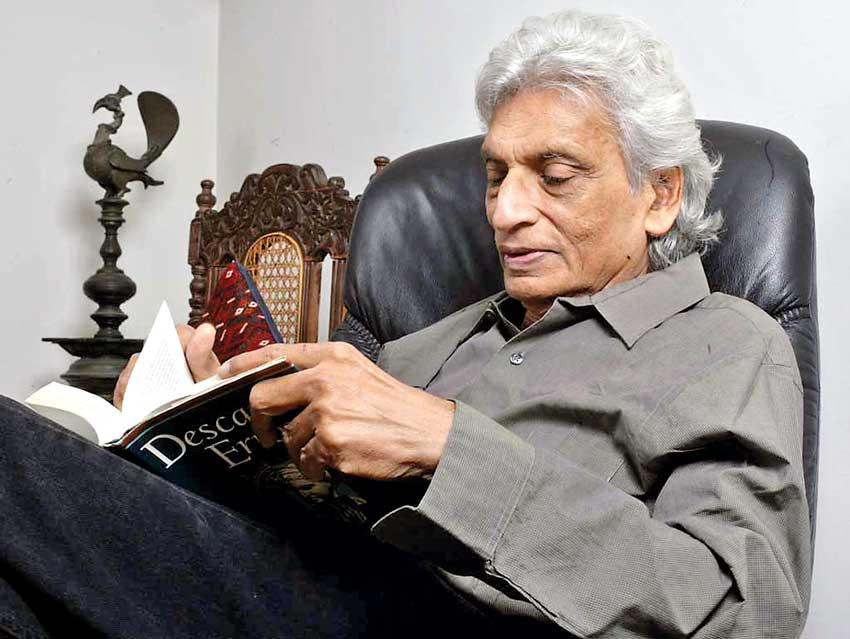Reply To:
Name - Reply Comment
Last Updated : 2024-04-25 00:00:00

 The Many Faces of the Kandyan Kingdom (1591-1765) by Gananath Obeyesekere - Perera-Hussein, 2020, 200 pp., Rs 1,200
The Many Faces of the Kandyan Kingdom (1591-1765) by Gananath Obeyesekere - Perera-Hussein, 2020, 200 pp., Rs 1,200
Gananath Obeyesekere’s lucid study of the Kandyan Kingdom provides an alternative account of how politics and culture intersected in the last capital of the Sinhalese kings. It is a welcome addition to research undertaken thus far on that chapter in Sri Lankan history. What makes it stand out is its refusal to accept the findings of other studies, and like The Doomed King, to which this can be read as a prequel, it serves to dispel certain myths and conventional wisdom regarding the Kandyan polity. Pugnacious and polemical, Obeyesekere makes no apologies for his conclusions. It is a work that resounds in narrative and analysis, and as such its appeal is not just to the academic, but also the lay reader.

The Kandyan Kingdom emerged as the last bastion of Sinhalese rulers in the latter part of the 16th century. Its origins remain deeply shrouded in enigma. While Obeyesekere tackles a certain period, spanning the accession of Vimaladharmasuriya (1591) until the peak of Kirti Sri Rajasinha’s reign (1765), the rise of Kandy as an autonomous administrative unit is considered to be the doing of Senasammata Vikramabahu, who came to power as ruler of Kandy at the time Bhuvanekabahu VI succeeded to the throne in Kotte; the Palkumbura Sannasa and inscriptions at Aluthnuwara and Gadaladeniya fix the year of his enthronement at 1473/1474, while the continuation of the Mahavamsa fixes it at 1542/1543.

Obeyesekere does not delve into this period, full of controversy and conjecture as it is. Instead he begins with the murder of Vimaladharmasuriya’s father, Virasundera, by the pretender of Sitavaka, Rajasinha.
Protean as politics in the Sinhala kingdom tended to be, loyalties were constantly shifting. Thus Vimaladharmasuriya, who with a confidante of his joined Don Juan Dharmapala’s campaigns against Rajasinha, overran the hill country, battled the forces of Sitavaka, and reneged on his allegiance to the Portuguese. Taking on a new name, he embraced Buddhism and set himself upon the throne, defying the authority of Kotte. Dazed and furious, the Europeans attempted to regain their power; their assaults on his territory would end up inadvertently providing the renegade with a queen.
The student of this period in Sri Lankan history invariably faces a conundrum: to what extent were the rulers of Kandy Sinhala and/or Buddhist? Being a Buddhist, after all, had been an explicit sine qua non of kinship since the 12th century. To the world outside, the ruler had to exhibit these credentials. Vimaladharmasuriya was no exception.
And yet, underlying his public face was his private persona: not only had he been a Catholic convert, his inclination towards Western customs became well known to European envoys visiting his Court. It is this disjuncture, between the public and the private, that has coloured our understanding of his successors as well. How are we to reconcile the two?
The Many Faces of the Kandyan Kingdom does not endeavour to resolve this question in full. It is lucid and accessible, yet it is also brief. Instead the author works his way around how its cosmopolitanism influenced, and shaped, the politics and culture of Kandy. Most scholarly accounts of the kingdom, Obeyesekere points out, have made use of two sources: the Pali and Sinhalese Chronicles, and accounts by visiting envoys. The problem is that while the former emphasise the ruler’s patronage of Buddhism, the latter emphasise his other side. So far as this concerns the first few monarchs – from Vimaladharmasuriya to Narendrasinghe – there is no issue. The issue comes up with those who succeeded to the Sinhala line (held to have ended with Narendrasinghe), the Nayakkars.
We know, from the observations of European visitors to the Court of Kandy like Spilbergen, Knox, De Lanerolle, Gascon, Hubbard, and Pybus, as well as Catholic missionaries like Joseph Vaz, that under Vimaladharmasuriya and his successors the Kandyan Kingdom turned into a flourishing cosmopolitan enclave. This trend was continued even by the ex-Buddhist priest Senarat, and it peaked during Rajasinha II’s time. Simmering down in Vimaladharmasuriya II’s reign, it cropped up again under the flamboyant Narendrasinghe, who as Obeyesekere notes has got something of a bad press today owing to his reputation as a sellam rajjuruwo: a result, he conjectures, of the onslaught of Protestant Buddhism in the 19th century, which tended to view such reputations as unbecoming of a Buddhist ruler.
With the coming of the Nayakkars, this cosmopolitan outlook recedes from view. The likes of Lorna Dewaraja have attributed that to their Dravidisation of the Kandyan polity. Even in their manner of dress and their habits – from their patronage of Hindu temples to their act of daubing holy ash on their foreheads – these scholars conclude that with them ended the rulers’ patronage of Buddhism in the last Sinhala capital. Typical, then, is Yasmin Rajapakse’s characterisation of this period: “[t]heir administration, combined with the growing practice of Hindu rituals that they set in place [my emphasis], created an atmosphere of uncertainty and insecurity... in the Kandyan Kingdom.”
Obeyesekere for his part finds such a view unacceptably reductionist. To him, there’s nothing that separated the devotion of these kings to Hindu practices from the devotion of earlier kings, even those in Polonnaruwa and Dambadeniya. Neither, for that matter, did this prevent these supposedly Dravidian rulers from lavishing patronage on Buddhism; in that sense Kirti Sri Rajasinha, under whom the upasampada of monks was re-established, went beyond his predecessors, including Narendrasinghe, in reclaiming Sri Pada from the Saivites who had occupied it since Rajasinha of Sitavaka gifted it to them.
Given the available evidence, the author seems all too justified in his assertion that the demonization of the Nayakkars as un-Sinhala, un-Buddhist, and un-Kandyan was largely the work of colonial (mainly Dutch) officials hostile to them. Right until the last chapter of this kingdom, which unfolds in tragic detail in The Doomed King, the conflict between the ideal of Tri Sinhale – “the three parts of the Sinhala land” – and the reality of European presence pitted the rulers, along with their Chief Ministers, against these officials. The British, whose interventions the author examines in The Doomed King, went one step ahead of the Dutch: while demonising the Nayakkars, they also conspired with their Chief Ministers. What came to pass, eventually, was the colonisation and burial of an entire country, an entire polity, and with it, an entire way of life.
In his previous article on Madapatha the author identified the Kolamunna ancestral family with the Madapatha Attygalles, without noting that the Attygalle family goes beyond the Madapatha side. The latter specifically was a family of well known ayurvedic physicians at Madapatha, buried adjacent to Phillip Attygalle Vidyalaya; established by and named after a family patriarch, it is run today as a fully-fledged state-run school. The author wishes to set the record straight. While not intending any insult to the families concerned, he admits this brief oversight and duly apologises for any harm caused, if any.
Sana Monday, 19 October 2020 03:24 AM
The last capital of the Sinhalese kings? Kandy was the last capital of Nayakkar kings from Tamil Nadu. Last Sinhala king was Vira Narendra Sinha .

Add comment
Comments will be edited (grammar, spelling and slang) and authorized at the discretion of Daily Mirror online. The website also has the right not to publish selected comments.
Reply To:
Name - Reply Comment
US authorities are currently reviewing the manifest of every cargo aboard MV
On March 26, a couple arriving from Thailand was arrested with 88 live animal
According to villagers from Naula-Moragolla out of 105 families 80 can afford
Is the situation in Sri Lanka so grim that locals harbour hope that they coul